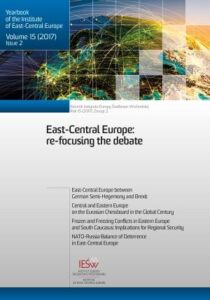Strony: 99-122
Wydanie: Lublin 2017
DOI: --
Sposób cytowania: R. Wiśniewski, ‘NATO-Russia Balance of Deterrence in East-Central Europe’, Yearbook of the Institute of East-Central Europe, Vol. 15, No. 2, 2017, pp. 99-122.
Słowa kluczowe: deterrence, Eastern Flank, NATO, Russia
Abstrakt:
This paper aims to analyze a crucial feature of East-Central Europe’s (ECE) security environment—the balance of deterrence in NATO-Russia relations. This particular factor is the most influential among all on the regional order in the ECE. It stems from the fact that the Russian Federation is the preponderant military power in the region. The fear of possible Russian belligerence was the number one factor behind the desire of many countries in the region to join the Alliance. As a result, Russia and NATO constitute the most important actors in the regional security order in the ECE, a reality made even starker in the wake of the Ukraine crisis. Since that began, the Russia-NATO relationship has turned antagonistic. As open military conflict has (for now) been precluded as an option by both sides, it is the balance of deterrence between them that drives the evolution of ECE security. This paper first establishes an understanding of what constitutes the balance of deterrence and which factors are most important for it. Then, it assesses the current balance by identifying both sides’ aims and strategies. Finally, a picture of the impact of the balance on regional security emerges.
Bibliografia:
https://journals.indexcopAsmus, R.D., ‘Europe’s Eastern Promise’, Foreign Affairs, Vol. 87, No. 1, 2008, pp. 95-106.
Berejikian, J.D., ‘A Cognitive Theory of Deterrence’, Journal of Peace Research, Vol. 39, No. 2, 2002.
Chekinov, S.G., Bogdanov, S.A., ‘The Nature and Content of a New-Generation War’, Military Thought, No. 4, 2013.
Davis, P.K., Toward Theory for Dissuasion (or Deterrence) by Denial: Using Simple Cognitive Models of the Adversary to Inform Strategy, RAND Working Paper, 2014, https://www.rand.org/pubs/working_papers/WR1027.readonline.html [2017-08-03].
Department of Defense Dictionary of Military and Associated Terms, as of March 2017, http://www.dtic.mil/doctrine/new_pubs/dictionary.pdf [2017-05-20].
Doran, Ch.F., ‘Imperatives of European Security at Russia’s Critical point on its Power Cycle’, Stosunki Międzynarodowe [International Relations], Vol. 51, No. 2, 2015.
Filipowicz, M., ‘The idea of East-Central Europe and its role in shaping the logic behind Eastern Partnership’, Yearbook of the Institute of East-Central Europe, Vol. 14, No. 6, 2016, pp. 69-86.
Foerster, S., ‘Strategies of Deterrence’, in: Jasper, S. (ed.), Conflict and Cooperation in the Global Commons. A Comprehensive Approach for International Security, Washington, DC: Georgetown University Press, 2012 [Kindle edition].
Galeotti, M., ‘The “Gerasimov Doctrine” and Russian Non-Linear War’, in: In the Moscow’s Shadows, 6-07-2014, https://inmoscowsshadows.wordpress.com/2014/07/06/the-gerasimov-doctrine-and-russian-non-linearwar/,Chekinov, [2015-09-12].
Gerson, M.S., ‘Conventional Deterrence in the Second Nuclear Age’, Parameters, Vol. 39, No. 3, 2009, pp. 32-48.
Graham, T., ‘The Sources of Russia’s Insecurity’, Survival, Vol. 52, No. 1, 2010.
Huth, P.K. ‘Deterrence and International Conflict: Empirical Findings and Theoretical Debates’, Annual Review of Political Science, Vol. 2, 1999, pp. 25-48.
Kissinger, H., Nuclear Weapons & Foreign Policy, New York: W.W. Norton & Company, Inc., 1969.
Kłoczowski, J., Europa. Rzeczpospolita Wielu Narodów. Świadectwa, wywiady, przemówienia i szkice z lat 1990-2012 [Europe Respublica of Many Nations. Testimonies, interviews, speeches and sketches from years 1990-2012], Lublin 2012.
Kupiecki, R., ‘The Poland-United States security relations in the light of asymmetry theory’, Przegląd Strategiczny [Strategic Review], No. 9, 2016, pp. 31-48.
Lupovici, A., ‘The Emerging Fourth Wave of Deterrence Theory—Toward a New Research Agenda’, International Studies Quarterly, Vol. 54, No. 3, 2010.
Military Doctrine of the Russian Federation 2014, https://www.theatrumbelli.com/the-military-doctrine-of-the-russian-federation/ [2017-06-30].
Morgan, F.E. et.al., Dangerous Thresholds Managing Escalation in the 21st Century, RAND Corporation, 2008, http://www.rand.org/content/dam/rand/pubs/monographs/2008/RAND_MG614.pdf [2017-05-26].
NATO, Warsaw Summit Communiqué Issued by the Heads of State and Government participating in the meeting of the North Atlantic Council in Warsaw 8-9 July 2016, http://www.nato.int/cps/en/natohq/official_texts_133169.htm [2017-06-04].
Ringsmose, J., Rynning, S., ‘Now for the Hard Part: NATO’s Strategic Adaptation to Russia’, Survival, Vol. 59, No. 3, 2017.
Russian National Security Strategy, December 2015—Full-text Translation, http://www.ieee.es/Galerias/fichero/OtrasPublicaciones/Internacional/2016/Russian-National-Security-Strategy-31Dec2015.pdf [2017-06-05].
Shlapak, D.A., Johnson, M.W., ‘Reinforcing Deterrence on NATO’s Eastern Flank Wargaming the Defense of the Baltics’, RAND Corporation 2016, https://www.rand.org/content/dam/rand/pubs/research_reports/RR1200/RR1253/RAND_RR1253.pdf [2017-06-04].
Smith, J., Hendrix, J., ‘Assured Resolve Testing Possible Challenges to Baltic Security’, Center for A New American Security, 2016, https://www.cnas.org/publications/reports/assured-resolve-testing-possible-challenges-tobaltic-security [2017-06-04].
Stent, A.E., ‘Restoration and Revolution in Putin’s Foreign Policy’, Europe-Asia Studies, Vol. 60, No. 6, 2008, pp. 1089-1106.
Szef BBN dla PAP: W Bukareszcie udało się wzmocnić jedność państw regionu [Chief of BBN for PAP: In Bucharest we have successfully strengthened the unity of regional states], BBN [National Security Bureau of Republic of Poland], 5-11-2017 https://www.bbn.gov.pl/pl/wydarzenia/7130,Szef-BBN-dla-PAP-W-Bukareszcie-udalo-sie-wzmocnic-jednosc-panstw-regionu.html [2017-08-03].
Trenin, D., A five-year outlook for Russian foreign policy: demands, drivers, and influences, Carnegie Endowment for International Peace, 2016, http://carnegieendowment.org/files/Trenin_Russian_FP_TF_clean.pdf [2017-08-03].
Wiśniewski, R., Hensarling, B., ‘Power in 2025: A Global Ranking’, R/evolutions: Global Trends & Regional Issues, Vol. 3, No. 1, 2015.
Ven Bruusgaard, K., ‘Russian Strategic Deterrence’, Survival, Vol. 58, No. 4, 2016.
Zapfe, M., ‘Deterrence from the Ground Up: Understanding NATO’s Enhanced Forward Presence’, Survival, Vol. 59, No. 3, pp. 147-160.ernicus.com/

PDF: Pobierz